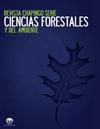散落在牧场上的热带干燥森林树木的落叶
IF 0.5
4区 农林科学
Q3 Agricultural and Biological Sciences
Revista Chapingo Serie Ciencias Forestales Y Del Ambiente
Pub Date : 2020-08-30
DOI:10.5154/r.rchscfa.2019.12.092
引用次数: 3
摘要
导言:热带干燥森林(TDF)中分散的树木将大量的凋落叶沉积到牧场土壤中。目的:研究旱季散种针叶水飞莲的凋落物产量。和白菖蒲。& Cham)。牧场上的西格勒和艾宾格树。材料与方法:在10-ha的草地上,每个树种10株分散分布,在旱季(11 - 5月)收集凋落物,并进行分类。测定凋落叶生物量、氮(N)、木质素(L)含量及木质素-氮(L/N)比。利用双逻辑模型对年周期的凋落叶进行了建模。所有变量的平均值在物种之间使用t检验进行比较。结果与讨论:种间凋落物、氮、木质素含量相近。结论:草地散落树木凋落叶的数量和质量有利于采用农林业系统,包括TDF的原生树种本文章由计算机程序翻译,如有差异,请以英文原文为准。
Litterfall from tropical dry forest trees scattered in pastures
Introduction: Scattered trees from tropical dry forests (TDF) deposit significant amounts of leaf litter into pasture soils.
Objective: To estimate the litterfall production during the dry season by scattered Lysiloma acapulcense (Kunth) Benth. and Vachellia pennatula (Schltdl. & Cham.) Seigler & Ebinger trees in pastures.
Materials and methods: Ten scattered trees of each species were selected from a 10-ha pasture, and litter was collected during the dry season (November to May) and sorted into fractions. Leaf litter biomass, nitrogen (N) and lignin (L) content, and the lignin-nitrogen (L/N) ratio were assessed. Leaf litterfall was modelled over an annual cycle using a double logistic model. Means from all variables were compared between species using a t-test. Results and discussion: Litter, nitrogen and lignin content were similar between species. However, the L/N ratio was significantly higher (P
Conclusion: The quantity and quality of leaf litter that scattered trees deposit in a pasture encourages the adoption of agroforestry systems, including tree species native to TDF
求助全文
通过发布文献求助,成功后即可免费获取论文全文。
去求助
来源期刊
CiteScore
1.20
自引率
16.70%
发文量
0
审稿时长
>12 weeks
期刊介绍:
The Revista Chapingo Serie Ciencias Forestales y del Ambiente (RCHSCFA) is a scientific journal that aims to raise awareness of high-quality research products related to forest, arid, temperate and tropical environments in the world. Since its foundation in 1994, the RCHSCFA has served as a space for scientific dissemination and discussion at a national and international level among academics, researchers, undergraduate and graduate students, forest managers and public/private entities that are interested in the forest environment.
All content published in the journal first goes through a strict triple-blind review process and is published in the following formats: Scientific Articles, Review Articles, Methodologies, Technical or Technological Notes.

 求助内容:
求助内容: 应助结果提醒方式:
应助结果提醒方式:


